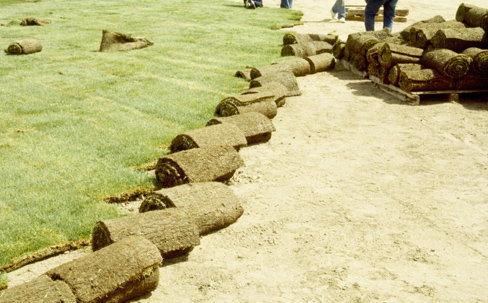Sod
Sod production involves growing a solid stand of high quality turfgrass and then harvesting the grass along with roots and a thin layer of topsoil. Many sod producers also transport and install the sod.
Marketing
The primary markets for sod are landscapers and building contractors. Sod is used in parks, golf courses, athletic fields, schools, garden centers, home lawns, road construction sites, commercial properties, and cemeteries. The demand for sod is highly dependent on new home construction and industrial development. Because turfgrass is highly perishable once harvested, sod is difficult to ship long distances, thus favoring local production. Most Kentucky-grown sod is marketed locally and little is exported to or imported from neighboring states. Although temporary sod shortages may occur, generally, shortages of cultivated sod in Kentucky are rare, indicating that current production is meeting demand. The market is extremely tight and new growers would have to produce a better quality turfgrass at a lower price to compete.
Production
 Kentucky bluegrass (Poa pratensis) and tall fescue (Festuca arundinaceae) are the two main sod grasses grown commercially in Kentucky. Other species that could be produced include bermudagrass (Cynodon dactylon) and zoysiagrass (Zoysia japonica). In the case of Kentucky bluegrass, two or three cultivars are blended for better disease resistance, as well as for more aggressive rhizome development and tillering. Two cultivars of tall fescue may similarly be blended; however, more commonly, only one variety is used. Instead, some Kentucky bluegrass can be mixed with the tall fescue seed in order to increase sod strength when harvesting. This is unnecessary when netting is used in tall fescue production.
Kentucky bluegrass (Poa pratensis) and tall fescue (Festuca arundinaceae) are the two main sod grasses grown commercially in Kentucky. Other species that could be produced include bermudagrass (Cynodon dactylon) and zoysiagrass (Zoysia japonica). In the case of Kentucky bluegrass, two or three cultivars are blended for better disease resistance, as well as for more aggressive rhizome development and tillering. Two cultivars of tall fescue may similarly be blended; however, more commonly, only one variety is used. Instead, some Kentucky bluegrass can be mixed with the tall fescue seed in order to increase sod strength when harvesting. This is unnecessary when netting is used in tall fescue production.

